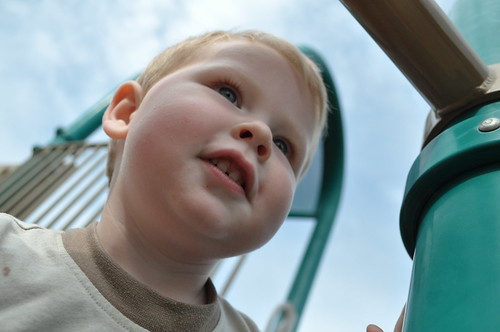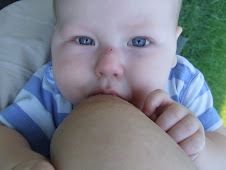Just to let you know, car crashes are the #2 killer of children under 1 year of age, it is the #1 killer of children 1-14.
The absolute bare minimum is 1 year AND 20lbs. What is best practice? To keep your child rear facing for as long as possible. The AAP recommends keeping your child rfing until the weight limits of your seat which is either 30, 33 or 35lbs. Another thing, MOST states have LAWS in place that say your child HAS to be in a rear facing child restraint until 1 year AND 20lbs. So ANY dr telling you that it is okay to FF them before 1 year is WRONG.
I am a Child Passenger Safety Technician and I all too often see the horrific aftermaths of children who were forward facing and were involved in a car accident. Most recently, we reviewed a case study of a 26 month old, 26lbs child who was in the middle of the backseat, ffing, in a 5 pt harness seat. A car came into their lane and they were in a head on collision at 45mph. This little girl suffered a broken C2 vertebrae. She was the LUCKIEST child. She was in a HALO for 3 months. She had to into temporary state custody b/c the mother couldn't care for her (due to the mother being in the hospital). Evidence shows that if she were still rear facing, she would not have sustained this life threatening injury.
I have had a broken neck before, my C1 and C2 vertebrae's were broken. This area controls breathing, movements, etc...Christopher Reeve is a prime example of having a broken C1 and C2 vertebra in his neck. It is NOT a nice injury and I would never wish that upon anyone...especially a child. It breaks my heart when I hear of parents ffing their child too soon. Because of this kind of mind set that it is a "milestone" to ff your child at 1 year AND 20lbs, many MANY children are needlessly injured.
When a child is in a frontal, head on 35mph crash and their car seat is NOT tethered and they are using a 5 point harness, they will go forward 32". When their seat is tethered, a child will be thrown forward 28". It is imperative that families recognize the NEED to keep their children rear facing for as long as possible.
Here are several links to support keeping your child rear facing for as long as possible.
http://aappolicy.aappublications.org/cgi/c...trics;109/3/550
http://www.carseat.org/Resources/633.pdf
http://www.cpsafety.com/articles/stayrearfacing.aspx
http://www.car-safety.org/rearface.html
http://www.cpsafety.com/articles/RFAlbum.aspx
http://www.thecarseatlady.com/car_seats/re...cing_seats.html
http://myangelsaliandpeanut.tripod.com/id5.html
http://momtoaliandshae.tripod.com/keepingkidssafeinthecar/
http://www.aap.org/family/carseatguide.htm
http://www.aap.org/family/1to2yrs.htm
http://www.aap.org/advocacy/releases/travelsafetytips.htm
http://www.youtube.com/watch?v=kRP7ynNI8mI
http://www.msnbc.msn.com/id/9916868
http://www.carseatsite.com/rear-face_article.htm
Here are a few crash test links to show you the difference in rear facing vs forward facing:
http://www.oeamtc.at/netautor/html_seiten/...icosipriori.mpg
http://youtube.com/watch?v=rsqE-uOtMM4&mode=related&search=
http://www.youtube.com/watch?v=K62Ea8Fs4ng...related&search=
Here is a crash test of a 12 month old RFing
http://smg.photobucket.com/albums/v163/jen_nah/carseats/?action=view¤t=video06A_MGA_213_RearFace-Convertib.flv
Then, here is the SAME 12 month old FFing
http://smg.photobucket.com/albums/v163/jen_nah/carseats/?action=view¤t=video06B_MGA_213_ForwardFace-Conver.flv
I think 15 links is enough for now, but I do have MANY MANY more showing support.
For those who say their children were uncomfortable rfing, your child knows nothing different. In fact, their legs bending the way they do RFing is actually comfortable to a child. It may not be for an adult. A child is usually more uncomfortable with their legs dangling over the edge or close to the edge of the seat than they are all "squished" up. ALL children go through the kicking, screaming, yelling phase b/c they are active, crawling, walking, etc and would much rather be doing that than harnessed in their seat. They also WANT to see mom or dad in the car. They can hear you, but can't "see" you. They are all phases and they will pass. A child is TOO tall rfing when their head is 1" below the top of the SHELL of the seat OR (check your car seat manual) if you own an older Britax, it is when the tips of the ears are even with the shell of the seat rfing. There is NO documented cases of a child's legs being broken in crashes, but there are TONS of documented cases of children with spinal injuries.
42% of accidents occur in rural settings. 25% of them occur within 5 minutes of your home.
Autopsy reports have shown that children under 2 years old are at 4 times the risk of Internal Decapitation when forward facing. What is Internal Decapitation??
Wikipedia says this:
Internal decapitation, atlantooccipital dislocation, describes the rare process by which the skull separates from the spinal column during severe head injury. This injury is nearly always fatal, since it usually involves nerve damage or severance of the spinal cord. Hanging relies on allowing the subject to break their neck under their own weight.
Here is a lady that actually survived Internal Decapitation http://youtube.com/watch?v=PWmJ1m3Jvhc&mode=related&search=
So, as you can tell, it has ZERO to do with neck STRENGTH. I was in a side impact crash where the drunk driver was going 65-70mph and it snapped my neck--I was 20 years old.
Did you know that if YOU are in a 30mph, one vehicle accident and your child weighs 20lbs, they turn into 600lbs of force. THAT is a LOT of force for a child.
Consider this: A car going 40mph would hit a tree with the same force as hitting the ground after falling off a 50 foot cliff. A person inside the car would hit the windshield (unrestrained, of course) with the same force as hitting the ground after a fall from a five-story building.
Another thing to know is that when a child is RFing, the BACK of their carseat--the part that goes behind their back and head--take the brunt of the crash force. In a FF car seat, the CHILD takes the brunt of the crash force.
This shows spine development. You can see how the spine doesn't fuse together until they are quite older.

This diagram shows you how "top heavy" children are and how disproportioned they are.

No one needs to feel bad or scared or worried. Here is the information. Some crashes are unsurvivorable no matter what safety precautions have been taken.
*reply to poster for code and repost*









